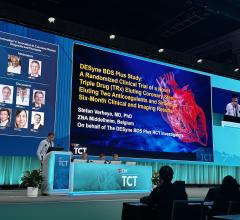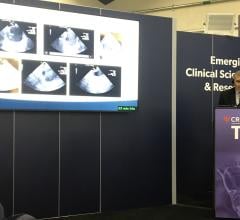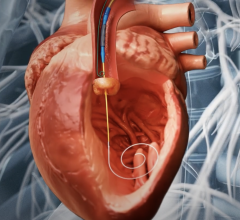
October 15, 2015 — One-year patient outcomes from the PARTNER II trial showed the low rate of 30-day complications with balloon-expandable transcatheter aortic valve replacement (TAVR) in high-risk and inoperable patients with aortic stenosis persisted with follow-up to one year.
One-year findings from the PARTNER II Sapien 3 study were presented at the 27th annual Transcatheter Cardiovascular Therapeutics (TCT) scientific symposium, sponsored by the Cardiovascular Research Foundation (CRF).
The initial PARTNER I trial demonstrated the early promise of TAVR with first-generation devices for high-risk (HR) and inoperable (INOP) patients. The PARTNER II Sapien 3 trial was a two-single-arm, non-randomized, historical-controlled study that utilizes the newest generation balloon-expandable TAVR device. Thirty-day outcomes, which were reported earlier this year at the American College of Cardiology (ACC) annual meeting, demonstrated very low rates of adverse events. The newest findings presented at TCT report results for the HR/INOP arm at one year.
The HR/INOP cohort of PARTNER II enrolled 583 patients (average age >80) at 29 U.S. sites with severe aortic stenosis who were deemed high-risk or inoperable for surgery. The follow-up rate at one year was 98.6 percent and the all-cause survival rate was 85.6 percent. Survival was 87.7 percent for transfemoral (TF) access procedures and 89.3 percent for high-risk patients treated by the TF route. The study also found that there was a low rate of disabling stokes at one year (2.4 percent) with no difference between HR and INOP or TF and TA.
Paravalvular aortic regurgitation also remained low, with 2.7 percent with moderate regurgitation and 29.1 percent with mild regurgitation at one year. Importantly, there was no increased mortality in the patients with mild regurgitation as compared to those with none or mild and no patient had severe regurgitation. Hemodynamic valve performance and early symptomatic improvement were also sustained at one year. All-cause mortality at 2.2 percent at 30 days and 14.4 percent at one year.
“The combination of new design features, procedural improvements, operator experience and improved patient selection have all contributed to a low rate of adverse events and a high rate of one-year survival in TAVR for high-risk and inoperable patients with severe aortic stenosis,” said study investigator, Howard C. Herrmann, M.D. “This represents a 50 percent reduction in mortality in both HR and INOP patients as compared with the first-generation TAVR device.” Herrmann is the John Winthrop Bryfogle Professor of Cardiovascular Diseases and director of Penn Medicine’s Interventional Cardiology Program in the Perelman School of Medicine at the University of Pennsylvania.
“This one-year follow-up data support the use of TAVR as the preferred therapy in high-risk and inoperable patients with aortic stenosis,” he said.
The Sapien 3 valve was approved in Europe in January 2014 and in the United States in June 2015 for the treatment of high-risk patients with severe aortic stenosis.
The PARTNER II Sapien 3 trial was funded by Edwards Lifesciences. Herrmann reports grant/research support from Abbott Vascular, Boston Scientific, Cardiokinetix, Edwards Lifesciences, Gore, Medtronic, Mitraspan, Siemens and St. Jude Medical. He also reported equity in MicroInterventional Devices, and speaking honoraria from Edwards Lifesciences.
For more information: www.tctconference.com


 November 09, 2023
November 09, 2023 








